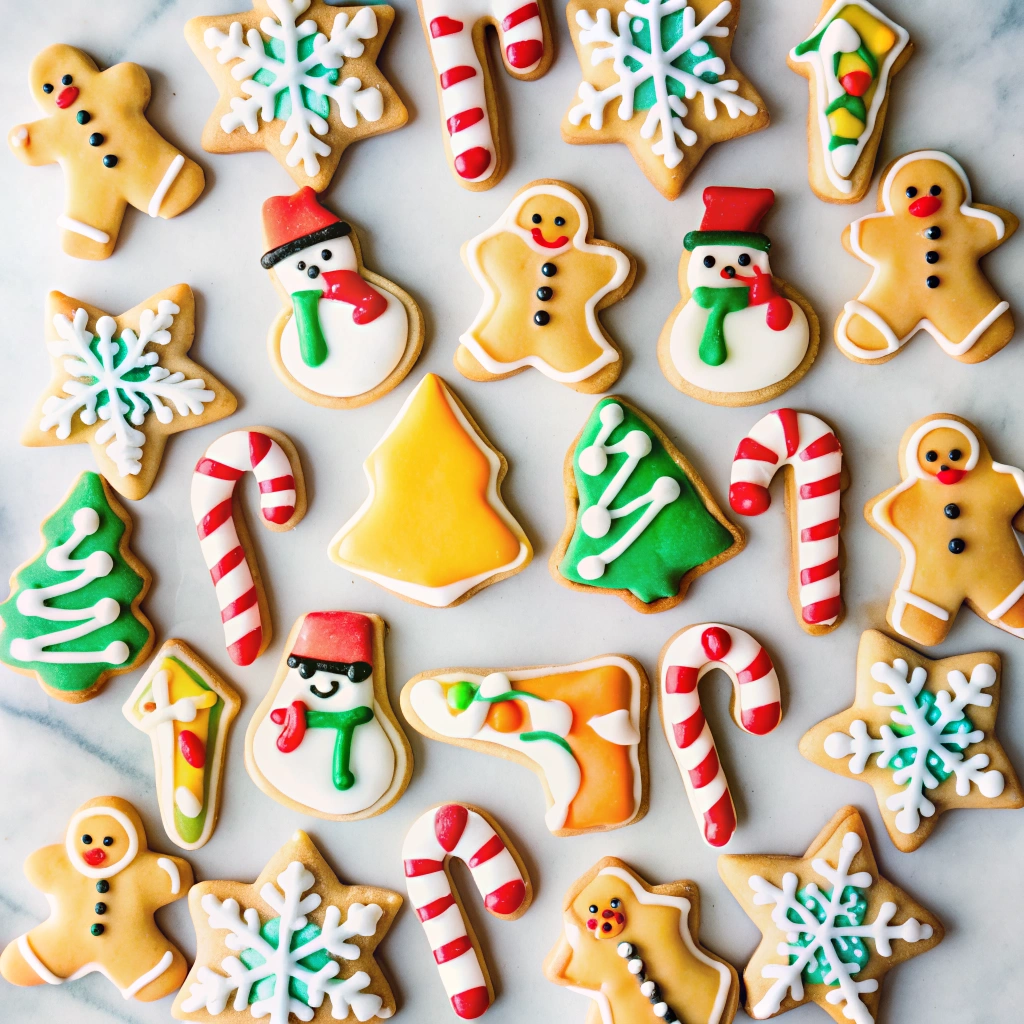
If you’ve ever admired those stunning, perfectly smooth, and intricately decorated Sugar Cookies on Pinterest, you know the secret lies in mastering Royal Icing. This is the ultimate guide to turning your simple cookies into edible works of art, whether you are a complete beginner or looking to perfect your technique.
This comprehensive tutorial breaks down the entire process: from making the best royal icing that dries hard and shiny, to achieving the two critical consistencies (outlining and flooding) that give professional results. Royal icing is essentially edible cement—it provides the structure for your designs and a perfectly smooth canvas. Once you master the technique of outlining and flooding, you’ll be able to create gorgeous, clean designs for any holiday or occasion.
We cover all the essential troubleshooting, including how to prevent craters in your icing and stop colors from bleeding. Get ready to elevate your baking—these decorated sugar cookies are guaranteed to be your family’s favorite new tradition!
Why Royal Icing is Essential for Cookie Decorating
Royal icing is the gold standard for cookie decorators because of its unique properties, achieved primarily through the use of meringue powder.
- Dries Rock Hard: Unlike a glaze (made with only powdered sugar and milk), royal icing contains proteins (from egg whites or meringue powder) that allow it to dry completely hard and brittle. This means you can stack, package, and ship your cookies without smudging the design.
- Perfectly Smooth Finish: The consistency of “flood” icing naturally settles and smooths itself out, eliminating brush strokes and creating a flat, professional-looking background known as the “canvas.”
- Color and Detail: Its structural integrity allows it to hold thin, delicate lines (the “outline”), which is essential for defining borders and adding fine details like lettering or delicate swirls.
- Safety and Stability: Using meringue powder (which we highly recommend) ensures the icing is safe (pasteurized egg whites) and delivers consistently stable results, regardless of weather or humidity.
Ingredients
The base recipe for royal icing is simple, but quality ingredients make a huge difference in the final product.
For the Perfect Royal Icing
- 4 cups (about 1 lb) confectioners’ sugar (powdered sugar), sifted
- 4 tablespoons meringue powder (DO NOT substitute with raw egg whites for consistency and safety)
- 1/2 teaspoon vanilla extract or clear extract (clear preserves the bright white color)
- 1/2 cup warm water, plus more for thinning
Tools and Supplies
- Piping Bags: Essential for control. Use disposable bags for easy color changes.
- Piping Tips: A small round tip (like Wilton #2 or PME 1.5) for outlining.
- Couplers: Recommended for quickly changing tips between colors/consistencies.
- Squeeze Bottles: Optional, but great for flooding large areas quickly.
- Toothpicks or Scribes: Absolutely critical for spreading, popping air bubbles, and detailing.
- Gel Food Coloring: (NOT liquid food coloring) Gel coloring creates vibrant colors without adding excess moisture, which would ruin the icing consistency.
Step-by-Step Instructions: Mix, Thin, and Decorate
Royal icing success hinges on achieving two distinct consistencies: Outlining (Stiff) and Flooding (Runny).
Part 1: Making the Base Icing (Stiff Consistency)
- Sift Dry Ingredients: In a large bowl or stand mixer, whisk together the sifted confectioners’ sugar and meringue powder. Sifting is crucial to remove lumps.
- Add Water: Add the 1/2 cup of warm water and the vanilla extract. Mix on low speed until just combined.
- Whip to Stiff Peaks: Increase the speed to medium-high and beat for 5–7 minutes. The icing is ready when it is thick, bright white, holds stiff peaks, and when you lift the beaters, the peak stands up straight without curling over. This is the Stiff/Outlining Consistency.
- Coloring: Divide the stiff icing into separate small bowls for coloring. Use a toothpick to add small amounts of gel food coloring, mixing thoroughly until you reach your desired hue.
Part 2: Achieving the Right Consistencies
The key to a smooth finish is knowing how to thin the icing using the “10-Second Rule.”
- The Outlining Consistency (Stiff/15-Second): This is the base icing you just made. It should be thick enough to hold its shape but soft enough to flow smoothly through a piping tip. When a spoonful of this icing falls back into the bowl, it should take about 15 seconds for the line to disappear entirely. Use this for piping borders, fine details, and lettering.
- The Flooding Consistency (Runny/5-10 Second): This consistency is used to fill in the outlined areas.
- Thinning: Take a portion of your stiff icing and gradually mix in water, one teaspoon at a time.
- Test: Drizzle a spoonful of the icing back into the bowl. It should take between 5 to 10 seconds for the drizzle to completely smooth and melt back into the surface of the icing.
- Store: Put the flooding icing into squeeze bottles or piping bags with a larger round tip (like a Wilton #3).
Part 3: The Decorating Process (Outline and Flood)
- Bake and Cool: Start with perfectly cooled, flat sugar cookies (ensure your cookie recipe has minimal spread!).
- Outline: Using the Outlining Consistency icing and a small round tip, pipe a continuous line around the entire perimeter of the cookie (or the area you want to fill). This border acts as a dam to hold the flood icing in place. Allow the outline to dry for 15-20 minutes so it is fully set before flooding.
- Flood: Fill the center of the outlined area with the Flooding Consistency icing. Start by gently squeezing the icing along the border, then fill in the center. Do not overfill!
- Spread and Pop: Use a scribe tool or a toothpick to gently push the icing to the edges, ensuring the entire area is covered smoothly. Use the same tool to drag over the surface, popping any air bubbles that have formed.
- Dry: Allow the flooded cookies to dry completely for 6–12 hours (ideally overnight). The surface should be hard and matte before attempting to add the next layer of detail.
- Add Details: Once the flood layer is bone dry, you can use the stiffer Outlining Consistency again to add decorative details, lines, dots, or lettering on top.
Pro Tips and Essential Troubleshooting

Cookie decorating is a skill that takes practice. Here are the most common challenges and how to fix them like a professional.
- Preventing Color Bleed: Color bleed happens when wet icing is applied next to or on top of another color that is not fully dry, or when too much liquid food coloring is used.
- Solution: Use gel food coloring only. If piping two colors side-by-side (wet-on-wet), ensure they are of the exact same 10-second consistency. For layered colors (details on a base), ensure the base layer is 100% dry (overnight) before adding the second color.
- Eliminating Craters (Holes in the Flood): Craters form when the surface of the flood icing crusts before the underside has completely set. This is common in the center of large flooded areas.
- Solution: Use a thicker flood icing (aim for 10-second consistency, not 5). After flooding, use your scribe to drag the icing along the borders toward the center, ensuring the icing is thickest at the edges. Bake the cookies for 5 minutes at 175∘F (80∘C) immediately after flooding. This low-heat setting accelerates the drying process and prevents craters.
- Fixing a Runny Icing: If you accidentally added too much water and the icing is thinner than 5 seconds, simply stir in more sifted powdered sugar, one tablespoon at a time, until the desired consistency returns.
- Piping Control: If your lines are wobbly, it means your hand is moving too close to the cookie. Hold the piping bag perpendicular to the cookie surface, and let the icing fall onto the cookie from a short distance—don’t drag the tip along the surface. Pipe the outline first, then go back over the wobbly sections to smooth them out before the icing dries.
- Humidity is the Enemy: Royal icing absorbs moisture from the air, which can dramatically slow the drying time or even cause it to remain tacky. If you live in a humid climate, use a dehumidifier in the room, or place the cookies in a warm, low-humidity area (like an oven with the light turned on).
Storing, Gifting, and Packaging
One of the great advantages of royal icing is how well the cookies store once they are completely dry.
Storage and Longevity
- Un-iced Cookies: Plain, baked sugar cookies can be stored at room temperature in an airtight container for up to 1 week, or frozen for up to 3 months.
- Iced Cookies: Cookies decorated with fully dried royal icing should be stored in an airtight container at room temperature. Do not refrigerate, as the condensation will make the icing soft and sticky. They will keep well for 2-3 weeks.
- Freezing Iced Cookies: You can freeze decorated cookies! Place the fully dried cookies in a single layer in a plastic container, then seal tightly. To thaw, do not open the container until it reaches room temperature (about 4 hours). Opening the container early can cause condensation to form on the icing, leading to color bleed and spotting.
Gifting and Packaging
- Perfect Packaging: Once the icing is completely hard, you can stack the cookies between layers of parchment paper or bubble wrap in a gift box.
- Heat Sealing: For maximum freshness and professional gifting, place each cookie in a food-safe cellophane bag and use a heat sealer to seal the bag completely.
- Labeling: Always include a small tag listing the flavor and ingredients for guests with allergies.
Frequently Asked Questions
- Can I use liquid food coloring instead of gel? It is highly discouraged. Liquid food coloring adds too much moisture to the royal icing, which significantly affects the consistency, makes it runnier, and increases the chance of color bleeding and craters. Always use concentrated gel food coloring.
- My icing dried with small air bubbles. How do I fix this? Air bubbles are common. They are caused by over-mixing the icing or not popping them right after flooding. Solution: Immediately after flooding a section, gently run a scribe tool or a toothpick over the surface, focusing on the bubbles, to pop them. You can also lightly tap the cookie on the counter to encourage the bubbles to rise to the surface.
- How long does royal icing last? Unused, leftover royal icing can be stored in an airtight container in the refrigerator for up to 1 week. Place plastic wrap directly on the surface of the icing to prevent a hard crust from forming. Before using, let it come to room temperature and whip it briefly to restore its texture.
- Is it safe to use raw egg whites in royal icing? It is generally safer to use meringue powder, as it is pasteurized and eliminates the risk of salmonella. Meringue powder also yields a much more stable, consistent result, which is crucial for structural integrity.
- What if my piping bag bursts? If your piping bag tears, it’s usually because you overfilled it or are gripping it too tightly. The solution is simple: double bag it! Place the torn bag (or the entire new bag) inside a second piping bag. This provides extra reinforcement and allows you to continue piping without a mess.
Mastering the art of Decorating Sugar Cookies takes practice, but by following these simple rules for icing consistency and drying, you will create beautiful, show-stopping cookies every time.
Don’t forget to Pin this royal icing guide for all your holiday decorating and share your favorite cookie shapes in the comments below!

Decorating Sugar Cookies
Ingredients
Equipment
Method
- In a bowl, whisk together flour, baking powder, and salt. Set aside.
- In a large mixing bowl, beat butter and sugar together until light and fluffy. Add egg and vanilla, mixing until combined.
- Gradually add dry ingredients to the wet mixture until dough forms. Divide dough in half, wrap in plastic, and chill for 1 hour.
- Preheat oven to 350°F (175°C). Roll chilled dough on a floured surface to 1/4-inch thickness. Cut out desired shapes using cookie cutters.
- Place cookies on parchment-lined baking sheets and bake 8–10 minutes, or until edges are just starting to turn golden. Cool completely before decorating.
- Prepare royal icing or buttercream. Divide and tint with food coloring as desired. Decorate cookies with piping bags, sprinkles, or colored sugars.
